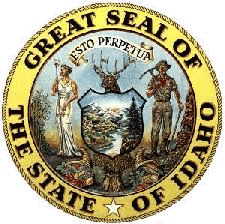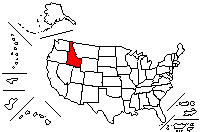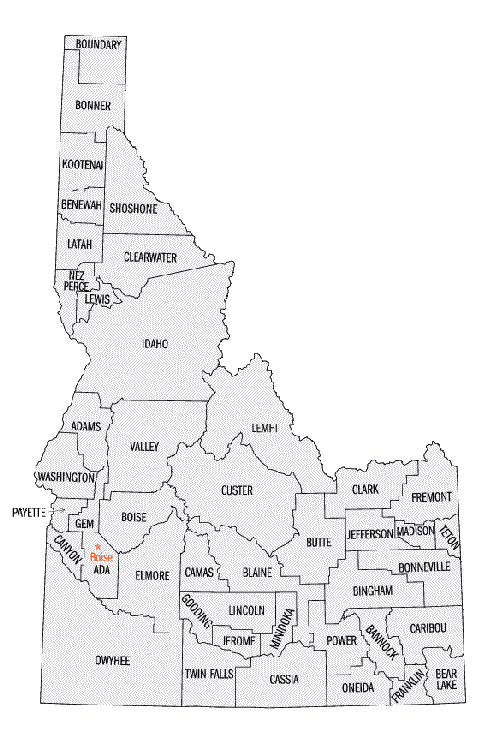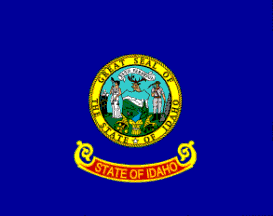
 |
|

















Here We Have Idaho |
Aquí está Idaho |


Flag:
A silk flag, blue field, with state seal of Idaho, in the center of a blue field.
The women represents liberty,
justice and equality. The man is a miner.
The pictures on the shield represent the main industries of forestry,
farming and mining. The cornucopias, or horn of plenty are symbols of abundance.
The elks head represents wildlife. Esto perpetua (Let it be perpetual or It is forever).
The words "State of Idaho" are embroidered in with block letters,
two inches in height on a red band three inches in width by twenty-nine inches in length,
the band being in gold and placed about eight and one-half inches from the lower border
of fringe and parallel with the same. Flag adopted 1907
Bandera:
Una bandera de seda, de campo azul, con el sello del estado de Idaho en el centro.
La mujer representa la libertad, justicia y la igualdad. El hombre es un minero. Las fotos en el
campo representan las principales industrias foreslates, agricultura y minería. Las cornucopias,
o cuernos de la plenitud son simbolos de abundancia. El alce representa la vida salvaje y tiene las
palabras Esto perpetua (sea por siempre). Las palabras "Estado de Idaho" están bordados con dos
pulgadas de alto en una banda roja de tres pulgadas de ancho por veinte y nueve pulgadas de
largo, la banda es en color oro y puesta a ocho pulgadas y medias sobre el borde inferior de la
bandera y paralelo a la misma. La bandera fué adoptado en el 1907.

Idaho
Capital City: Boise
Admission to Statehood: July 3, 1890
Border States: Montana - Nevada - Oregon - Utah - Washington - Wyoming
Motto: Esto perpetua (Let it be perpetual)
It is forever
This motto is attributed to venetian theologian
and mathematician Pietro Sarpi (1552-1623) who, in 1623, applied it to the Republic of
Venice. This motto was chosen by the Grange in 1867 and by the state of Idaho in 1891.
Nickname: Gem State
National: Idahoans
Origin of state's name: Named by USA citizanes. Idaho is a coined or invented word,
and is not a derivation of an Indian phrase "E Dah Hoe (How)"
supposedly meaning "gem of the mountains".
Idaho (se pronuncia ái-da-jo en inglés y español)
Cuidad Capital: Boise (se pronuncia Boiss en inglés y español)
Admición como estado: 3 de julio de 1890
Estados limítrofes: Montana - Nevada - Oregon - Utah - Washington - Wyoming.
Lema: Esto perpetua (sea por siempre)
Este lema es atribuido al teólogo y matemático veneciano
Pietro Sarpi (1552-1623) quien en el 1623 aplicó a la República de Venecia. Este Lema fue escojido
por el territorio 1867 por el estado estado de Idaho en 1891.
Cognómento: Estado Gema
Gentilicio: idahoeño (se pronuncia áidajoeño) Idaho se pronuncia á-ida=jo.
Origen del nombre: Nombre dado por ciudadanos americanos. Idaho es una palabra inventada, y no una derivación de una frase
india "E Dah Hoe" (en inglés se pronuncia "I Dah How") (en español es " Ai da jau"),
que supuestamente significa "gema de las montañas".


The Seal:
DESCRIPTION OF THE IDAHO STATE SEAL
DESCRIPCIóN DEL SELLO DEL ESTADO DE IDAHO
In 1957, the thirty-fourth session of the Idaho legislature authorized the updating
and improvement of the Great Seal in order to more clearly define Idaho's main industries,
mining, agriculture and forestry as well as highlight the state's natural beauty.
Paul B. Evans and the Caxton Printers, Ltd. were commissioned to revise the seal.
This painting by Paul B. Evans officially replaced the original design by Emma
Edwards Green and is designated as the "Official Copy."
The official Great Seal of the State of Idaho can be seen in the office of the Secretary
of State.
EMMA EDWARDS GREEN: at the period when she designed the Great Seal for the State of Idaho.
The only woman ever to achieve such distinction in the United States,
she won in competition sponsored by the First Legislature for the State of Idaho.
One of the most beautiful and impressive state seals, the original painting is held in trust by
the Idaho Historical.
By Emma Edwards Green
Before designing the seal, I was careful to make a thorough study of the resources and
future possibilities of the State. I invited the advice and counsel of every member of
the Legislature and other citizens qualified to help in creating a Seal of State that
really represented Idaho at that time. Idaho had been admitted into the Union on July 3rd,
1890. The first state Legislature met in Boise on December 8, 1890, and on March 14th, 1891,
adopted my design for the Great Seal of the State of Idaho.
The question of Woman Suffrage was being agitated somewhat, and as leading men and politicians
agreed that Idaho would eventually give women the right to vote, and as mining was the chief
industry, and the mining man the largest financial factor of the state at that time,
I made the figure of the man the most prominent in the design, while that of the woman,
signifying justice, as noted by the scales; liberty, as denoted by the liberty cap on the end
of the spear, and equality with man as denoted by her position at his side, also signifies
freedom. The pick and shovel held by the miner, and the ledge of rock beside which he stands,
as well as the pieces of ore scattered about his feet, all indicate the chief occupation of
the State. The stamp mill in the distance, which you can see by using a magnifying glass, is
also typical of the mining interest of Idaho. The shield between the man and woman is
emblematic of the protection they unite in giving the state. The large fir or pine tree in
the foreground in the shield refers to Idaho's immense timber interests. The husbandman
plowing on the left side of the shield, together with the sheaf of grain beneath the shield,
are emblematic of Idaho's agricultural resources, while the cornucopias, or horns of plenty,
refer to the horticultural. Idaho has a game law, which protects the elk and moose. The elk's
head, therefore, rises above the shield. The state flower, the wild Syringa or Mock Orange,
grows at the woman's feet, while the ripened wheat grows as high as her shoulder. The star
signifies a new light in the galaxy of states. . . . The river depicted in the shield is our
mighty Snake or Shoshone River, a stream of great majesty.
In regard to the coloring of the emblems used in the making of the Great Seal of the State of
Idaho, my principal desire was to use such colors as would typify pure Americanism and the
history of the State. As Idaho was a virgin state, I robed my goddess in white and made the
liberty cap on the end of the spear the same color. In representing the miner, I gave him the
garb of the period suggested by such mining authorities as former United States Senator
George Shoup, of Idaho, former Governor Norman B. Willey if Idaho, former Governor
James H. Hawley of Idaho, and other mining men and early residents of the state who
knew intimately the usual garb of the miner. Almost unanimously they said,
"Do not put the miner in a red shirt." "Make the shirt a grayish brown,"
said Captain J.J. Wells, chairman of the Seal Committee. The "Light of the Mountains"
is typified by the rosy glow which precedes the sunrise.
En el 1957, la trigesimo cuarta sesión de la legislatura de Idaho autorizó la actualización
y mejoras del Sello en orden de definir más claramente las principales industrias de Idaho,
minería, agricultura y fuentes forestales al igual que la gran belleza natural del Estado.
Este sello, pintado por Paul B. Evans reemplazó oficialmente el diseño original de Emma Edwards
Green y es designado como la Copia Oficial.
El Sello oficial del Estado de Idaho puede ser visto en la oficina del Secretario de Estado.
EMMA EDWARDS GREEN: En el período cuando se diseño el Gran Sello de Estado de Idaho, fué la única
mujer que haya logrado dicha distinción en los Estados Unidos, ella ganó en una competencia
auspiciado por la legislatura del Estado de Idaho. Uno de los más hermosos e impresionantes sello,
la pintura original estáa en custodia segura por el Idaho Historical.
por: Emma Edwards Green
Antes de diseñar el sello, tube mucho cuidado en hacer un estudio de los recursos y de las posibilidades
futuras del Estado. Consuté a todos los miembros de la legislatura y a otros ciudadanos cualificados
que ayudara en la creación del Gran Sello del Estado que realmente representara a Idaho
para este tiempo. Idaho fué admitido en la unión el 3 de julio de 1890. La primera legislatura
del Estado se reunió en Boise el 8 de diciembre de 1890 y el 14 de marzo de 1891, adoptó mi
diseño para el Gran Sello del Estado de Idaho.
La asunto del derecho al voto de la mujer ha estado inquieto de alguna forma y a llevado a los
hombre y a los politicos a estar de acuerdo que, eventualmente, se le daría el derecho al voto
a la mujer y como la minería fué la industria principal y el minero fué el factor financiero
más grande para el estado en este tiempo, he hecho la figura del hombre la más sobresaliente
en el diseño, mientras que a la mujer se le dió el significado de justicia que se vé con la
balanza de libertad que es presentado como un birrete al final de la lanza y la igualdad con el
hombre es presentado con la posición de ella al lado de este que también significa libertad.
El pico y la pala sujetado por el minero y la roca al lado del cual él está al igual que todo el
mineral que está dispersado en sus pies, todo ello indica su ocupación como jefe del estado.
La estampa del molino en la distancia, el cual se puede ver utilizando una lupa, es también algo
típico a los intereses mineros de Idaho. El escudo entra la mujer y el hombre es simbólico a la
protección que ellos, unidos, le dan al estado. El gran abeto o pino en el fondo dentro del escudo es
referente a los interesea madereros de Idaho. El hombre arando en el lado derecho dentro del escudo
junto con el fajo de granos el el que se apoya el escudo es simbólico a los recursos agrícolas
de Idaho mientras que los cornucopias o cuernos de la abundancia, se refiere a la siembra de ortalizas.
Idaho tiene leyes de caza el cual protege a los alces y ciervos, por lo tanto, la cabeza de un
alce sobresale encima del escudo. La flor del estado, la Syringa salvaje o Imitación de Naranja
crece a los pies de la mujer mientras que el trigo maduro crece tan alto como sus hombros.
La estrella significa la nueva luz en la gralaxia de estados.
El río dibujado en el escudo es nuestra podera Seperteante o Río Shoshone en una torrente de
gran majestuosidad.
En consideración para los colores utilizado en el Gran Sello del Estado de Idaho, mi principal
deseo al usar esos colores era tipificar el puro Americanismo e historia del Estado. Como Idaho
era un estado virgen, Yo vestí con una toga blanca a la mujer e hice el birrete de la libertad en
el final de la lanza, del mismo color. En representación al minero, le dí la vestidura de su
período como fué sugerido por las autoridades mineras como el anterior senador de los Estados Unidos
George Shoup, de Idaho, el ex-gobernador Norman B. Willey, de Idaho, el ex-gobernador de Idaho
James H. Hawley y de otros mineros que fueron los primeros residentes del Estado de Idaho
quienes conocían intimamente las vestiduras de los mineros. Casi unanimamente dijeron: "No coloques
al minero con camisa roja". "Has la camisa con un tono marrón grisaseo", dijo el Capitán
J.J. Wells, presidente del comité del Sello. La "Luz de las Montañas" es presentado
por el brillo rosado el cual presede al amanecer.

HISTORY
Idaho, a Pacific Northwest state, links the Great Plains and
the Northwest coast. It is bounded on the north by British Columbia,
on the east by Wyoming and Montana, and on the south by Utah and
Nevada. Its western border with Oregon and Washington follows,
in part, the course of the Snake River. The Rocky Mountains dominate
the entire landscape except for the Snake River plain, which cuts
across the southern part of the state. Idaho's wealth of natural
resources and its scenic attractions form the base of the state's
economy.
By the 18th century Idaho was the home of six Indian tribes:
Kutenai, Pend d'Oreille (or Flathead), Coeur d'Alene, and Nez
Perce in the north; and Northern Shoshoni and Northern Paiute
(known as Bannock) to the south.
After the Lewis and Clark
Expedition discovered the Salmon and Clearwater
country in 1805-06, fur trappers explored the rest
f Idaho in search of beaver. Idaho's Snake River area became
a disputed borderland in which British and French trappers,
based in Montreal and the lower Columbia River valley, competed
with U.S. adventurers from Saint Louis. By 1840 trapping had
almost ended, and the Hudson's Bay Company gained control of the
region. The United States acquired the southern part of the
Oregon country, including all of present-day Idaho, in 1846.
Hudson's Bay Company, with posts at Fort Hall and Fort Boise,
continued to serve the settlers traveling to the west over the
Oregon Trail and California Trail. Permanent white settlement
began in 1860, when Mormons moved northward from Utah and miners
arrived from the Pacific coast.
Statehood
Idaho, un estado del noroeste pacífico, entre los grandes
llanos y la costa del noroeste. Es limitado en el norte por British
Colombia, en el este por el Wyoming y Montana, y en el sur por el
Utah y el Nevada. Su frontera occidental con Oregon y Washington
sigue, en parte, el curso del Snake Rive. Rocky Mountains domina
el paisaje a excepción del llano del Snake River,
que corta a través de la parte meridional del estado.
La abundancia de Idaho de recursos naturales y sus atracciones
escénicas forman la base de la economía del estado.
Por el décimo octavo siglo Idaho era el hogar de seis tribus indias:
Kutenai, Pend d'Oreille (o de cabeza llana), Coeur d'Alene, y Nez
Perce en el norte; y Shoshoni norteño y Paiute norteño (conocidos
como Bannock) al sur.
Después de que la expedición Lewis y Clark descubrió los salmones y
aguas claras en
el país en 1805-06, tramperos exploraron el
resto de Idaho en la búsqueda del castor. El área del Snake River
de Idaho se convirtió en una frontera disputada en el cual
los tramperos británicos y franceses, basados en Montreal y al sur de
Columbia River Valley, compitieron con los aventureros de
ESTADOS UNIDOS Saint Louis. Antes de 1840 la interceptación casi
había terminado, y la Bay Company del Hudson ganó el control de la
región. Los Estados Unidos adquirieron la parte meridional del país
de Oregon, incluyendo todo el Idaho actual, en 1846. Bay Company de
Hudson, con los puestos en Fort Hall y Fort Boise,
continuó sirviendo a los colonos que viajaban al oeste sobre
Oregon y California. El establecimiento blanco
permanente comenzó en 1860, cuando los mormones se movieron hacia el
norte desde Utah y los mineros llegaron de la costa pacífica.
Estadidad
After territories were formed in Montana
(1864) and Wyoming (1868), Idaho's boundaries
enclosed two areas divided by mountains. For
a quarter-century, North Idaho tried without success
to form a new territory with eastern Washington, or,
s a last resort, rejoin Washington. The U.S. Congress
voted in 1886-87 to annex North Idaho to Washington
Territory, but President Grover Cleveland was persuaded
not to approve that change.
Although Idaho Territory had been overwhelmingly Confederate
Democratic after 1864, a coalition of Republicans and anti-Mormons
gained power in 1882. By 1888, Idaho had become safely Republican.
In attempting to establish control over the U.S. Congress,
the Republicans voted for admission of the territory to the union.
Idaho was made a state on July 3, 1890.
Después de que se formaron los territorios de Montana
(1864) y Wyoming (1868), los límites de Idaho incluyó dos áreas
divididas por las montañas. Para un cuarto-siglo, el norte de Idaho
intentaron sin éxito formar un territorio nuevo con Washington
del este o, como último recurso, unirse al territorio de Washington.
El congreso de ESTADOS UNIDOS votó en 1886-87 para
anexar Idaho del norte al territorio de Washington, pero presidente
Grover Cleveland no aprobó ese cambio. Aunque el territorio de Idaho
había sido demócrata confederada de forma aplastante después de
1864, una coalición de republicanos y de anti-Mormones ganó el poder
en 1882. Antes de 1888, Idaho se convirtió
republicano. En procurar establecer control sobre el congreso de
ESTADOS UNIDOS, los republicanos votaron por la admisión del
territorio a la unión. Idaho fue hecho un estado de julio el 3 de
1890.
